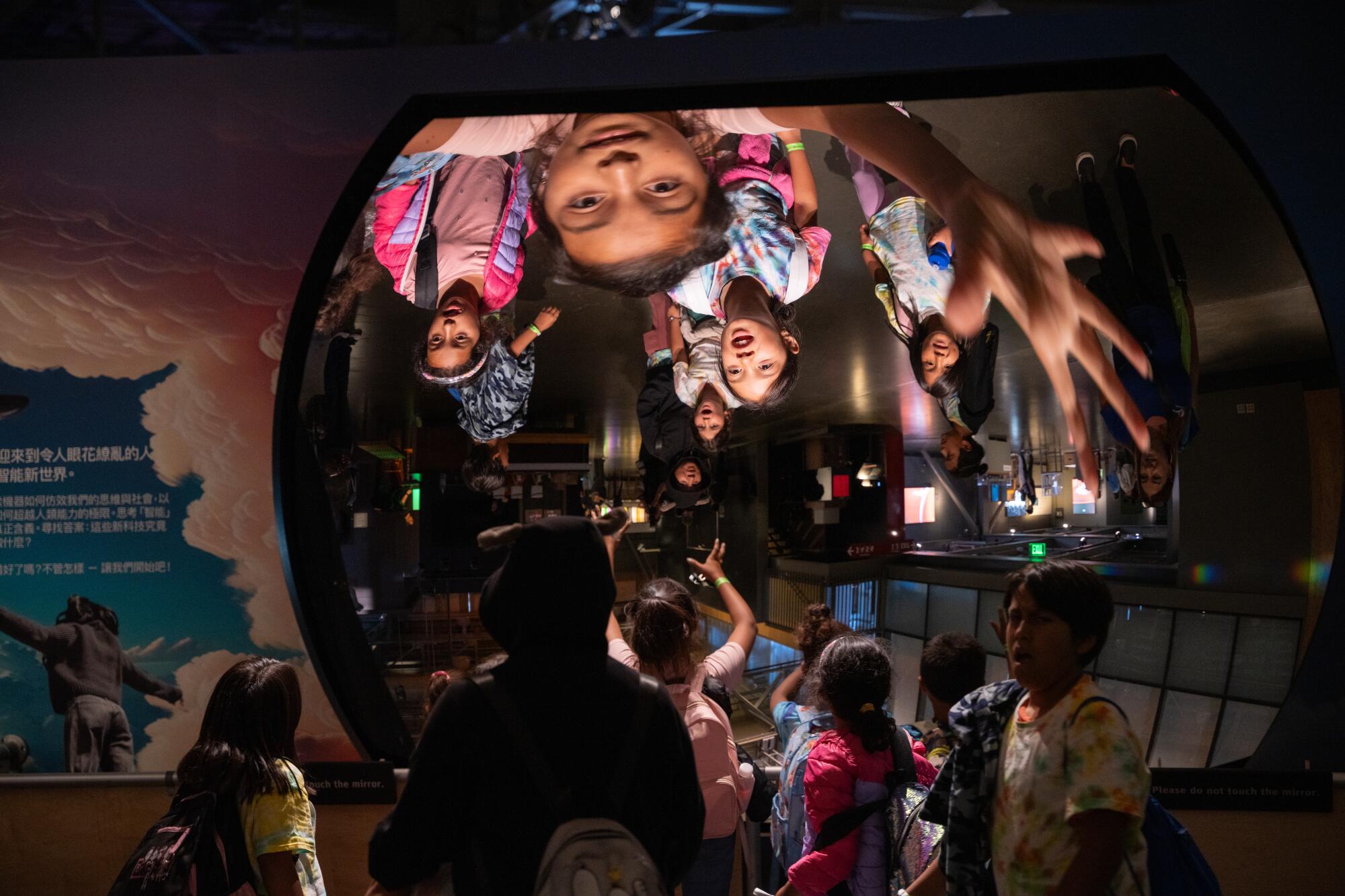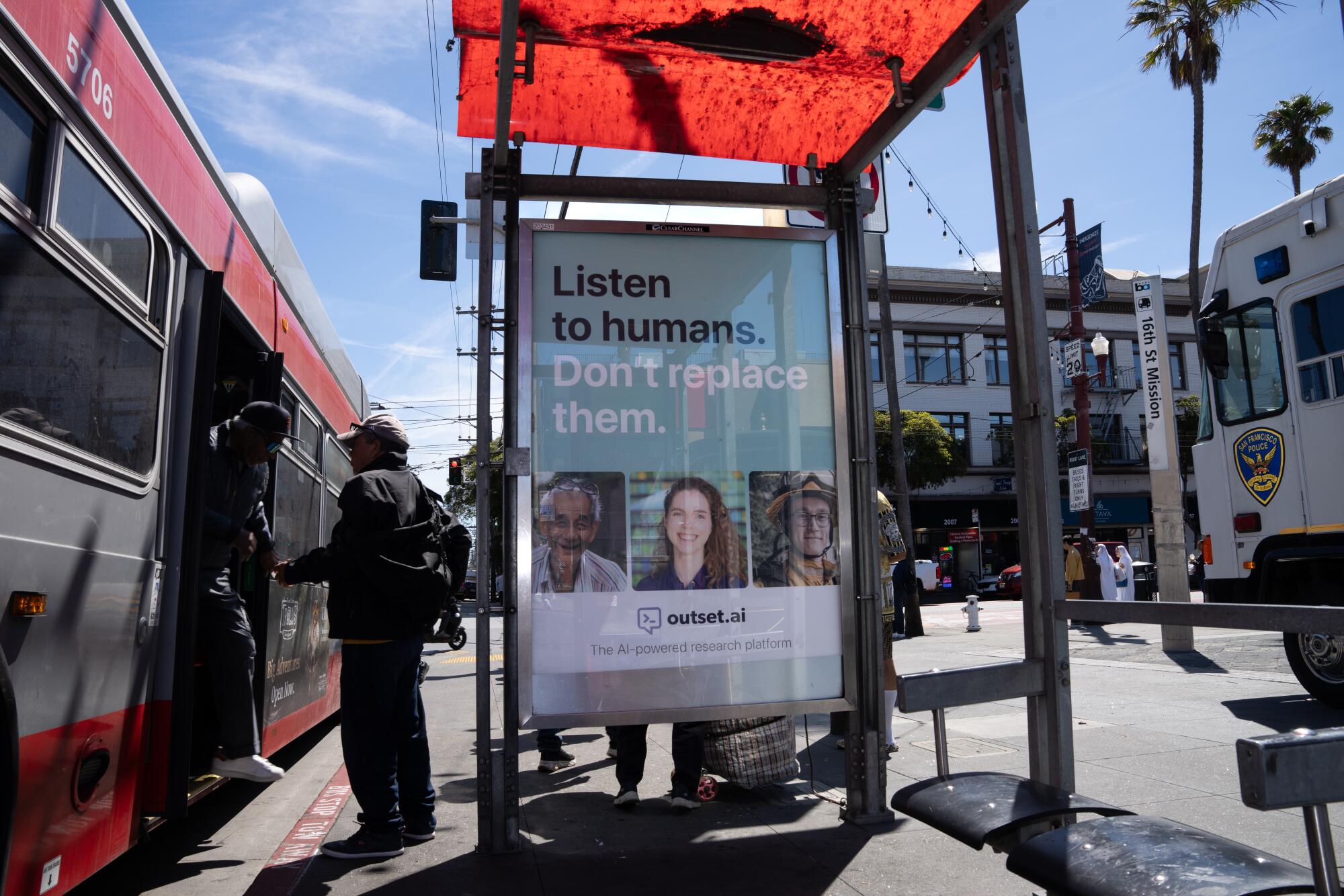-
FedEx Cup: Five Players Who Crumbled at St. Jude Championship - 33 mins ago
-
What the Nvidia Chip Payoff Deal Says About Trump’s Trade War - 41 mins ago
-
Pakistan Makes Nuclear Threat to India From US Soil - about 1 hour ago
-
The Harvard-Trained Lawyer Behind Trump’s Fight Against Top Universities - about 1 hour ago
-
To tackle homelessness, Los Angeles moves to centralize its response - about 1 hour ago
-
Max Verstappen Uncovers Crucial McLaren Secret Behind its F1 Domination - 2 hours ago
-
Miguel Uribe, Colombian Senator Shot at Campaign Event, Dies at 39 - 2 hours ago
-
From rescued to rescuer: Sydney helps Eaton fire evacuees heal - 2 hours ago
-
Huskies Left Behind After Owners Moved Out Now Seek a Forever Home - 2 hours ago
-
UCLA and Newsom go to battle with Trump over grant freezes, $1-billion fine - 3 hours ago
A new gold rush? How AI is transforming San Francisco
On a sunny day in San Francisco, along the city’s waterfront, families dived into the wacky world of artificial intelligence inside the Exploratorium museum.
Visitors made shadow puppets for AI to identify, used AI to generate songs, asked chatbots questions and faced off with AI in a game in which players tried to draw images that only humans would recognize. A giant robot hand moved around and people peered into a video game chip.
They jotted down their hopes and worries about AI on cards displayed in the museum. Hope: AI will cure cancer. Worry: People will rely on AI to the point they can’t think for themselves.

A visitor listens to the audio component of the “Mistaking AI” exhibit at the Exploratorium’s “Adventures in AI” in downtown San Francisco on Thursday.

Billboards for the AI company Fin line Interstate 80 as the freeway enters the Financial District on Wednesday in San Francisco.
“It sort of breaks down those guardrails, those big walls that people have put up around AI, and allows them to have a conversation with somebody else,” said Doug Thistlewolf, who manages exhibit development at the Exploratorium.
Art. Office Space. Billboards. Protests. The AI craze has intensified in San Francisco, spreading through work and social life in what some have described as a new gold rush. The AI boom, coupled with the election of new Mayor Daniel Lurie, has also infused the city with optimism — tinged with anxiety. Some worry about the city’s high cost of living, and whether AI will replace workers as tech layoffs continue.
For years, Silicon Valley has been at the center of innovation with some of the world’s valuable tech companies such as Meta, Google, Apple and Nvidia locating their massive headquarters south of San Francisco. AI’s rise, though, has shone a bright spotlight on San Francisco, home to multibillion-dollar companies such as OpenAI, Scale AI, Anthropic, Perplexity and Databricks.
AI has long played a big role in consumer technology, helping to recommend social media posts, translate languages and power virtual assistants. But the popularity of OpenAI’s ChatGPT — a chatbot that can generate text, images and code — set off a fierce race to propel technology that touches industries from media to healthcare.
Companies are battling it out for talent, offering lucrative compensation to recruit top researchers and leaders, while investments in AI companies have surged.
In the first half of 2025, venture capital funding for AI companies in the San Francisco Metro area surpassed $29 billion — more than double the amount during the same period in 2022, data from PitchBook shows. As of Aug. 5, VC deals for AI startups in the area, which includes San Francisco, Oakland and Fremont, made up 46.6% of funding for U.S. AI companies this year.

The headquarters of OpenAI, the maker of the popular chatbot ChatGPT, in Mission Bay, San Francisco.
Exactly how this frenzy will shape the future of San Francisco, home to cable cars and robotaxis, remains to be seen. Ask ChatGPT what SF will look like in 10 years and it generates an image of the city’s skyline with futuristic architecture and flying saucers next to the Golden Gate Bridge.
AI has been a “bright spot” in the city’s economy, helping San Francisco to recover after retailers, office workers and some companies such as X (formerly Twitter) left the downtown area during and after the pandemic as remote work picked up.
“The economic impact is [AI companies] take more office space, they pay more taxes, they hire more people,” said Ted Egan, chief economist of the city and county of San Francisco.
Over the past five years, AI-related companies have leased more than 5 million square feet of San Francisco office space and the amount is projected to grow, according to CBRE, a real estate service and investment firm. The city’s office vacancy rate of 35.8% in the first quarter would be cut in half if these companies take up 16 million square feet of office space by 2030.
San Francisco resident Vijay Karunamurthy has seen the city’s boom and bust cycles unfold over the last 25 years while working at startups and tech giants such as Google and Apple.
In 2000, when he moved from Chicago to San Francisco for an engineering job at a data startup, he saw major business such as Pets.com collapse during the dot-com crash. Fueled by social media’s popularity, the city’s tech sector came roaring back only to take a hit during the COVID-19 pandemic.
Now the city is ascending yet again. Ambitious entrepreneurs, old and new, are advancing powerful artificial intelligence tools that could transform lives.
“That amount of energy being concentrated in San Francisco has just been huge for the city,” said Karunamurthy, 46, the former field chief technology officer at Scale AI, a data-labeling startup. “It means every single night there’s AI events, and if you go to a coffee shop, you’ll run into people working on AI.”
Still, there are plenty of AI skeptics. In late July, outside of OpenAI’s headquarters in Mission Bay, a small group of protesters including a person dressed up as a robot held up signs that said “AI will kill us all” and “AI steals your work to steal your jobs.”

Children interact with the “Giant Mirror” at the Exploratorium’s “Adventures in AI” exhibition in Downtown San Francisco on Thursday.
Generative AI’s ubiquity has forced educators to rethink what and how they teach students in the classrooms.
Arno Puder, professor and chair of San Francisco State University’s computer science department, said generative AI represents a historic “paradigm shift.”
The longtime San Francisco resident is equally excited, but also a little scared, about how it will affect labor. Over the last two years, he’s seen student enrollment in computer science at the university drop amid tech layoffs and generative AI’s rise. As coding assistants reshape computer science jobs, the university launched a new undergraduate certificate in generative AI for the fall of 2026.
“Generative AI is a different beast,” Puder said. “That does make me worry a little bit, but if you ask me for a prediction on what services or what the world’s going to look like in a few years from now, I don’t know.”
AI’s rise has inspired the creation of new spaces throughout San Francisco where people can discuss technology’s benefits and risks.


Notes written by people visiting the Exploratorium’s “Adventures in AI” exhibition list their greatest worries and hopes related to artificial intelligence in Downtown San Francisco on Thursday.
Thistlewolf said creating the AI exhibit at the Exploratorium involved talking to workers and researchers from tech companies and universities. The exhibit, which runs through mid-September, took roughly a year and half to develop.
Backed by Anthropic, the San Francisco company that developed the AI chatbot Claude, the exhibit aims to educate people about AI but doesn’t shy away from the debate surrounding technology.
San Francisco resident Martha Chesley, 77, came to the exhibit with her grandchildren. Living in San Francisco for 50 years, Chesley sees potential benefits from AI companies coming to the city.
“If it brings people and money, it’s good for the city because right now we have a lot of closed storefronts,” she said. “Maybe there would be more money also for housing being built.”
Throughout the city, AI startups are broadcasting their mission loudly on billboards and ads displayed at bus stops and train stations. Messages include “Stop Hiring Humans. To Write Cold Emails” and “Droids ship software while you touch grass.”

A bus stop advertises Outset, an AI software company, in the Mission District in San Francisco.
(Florence Middleton/For The Times)
AI ads could also be spotted in the Mission district, a neighborhood deeply rooted in Latino culture and history. The area, filled with popular taquerias, colorful murals and a park with a view of the downtown skyline, has struggled with homelessness like other parts of the city.
At a bus stop on 16th Street, an ad from AI startup Outset struck a positive tone: “Listen to humans. Don’t replace them.”
Founded in downtown San Francisco in 2022, Outset created an AI interviewer so researchers could quickly gather feedback from more people to better understand customer needs and improve products.
The company’s 36-year-old chief executive, Aaron Cannon, said before the rise of ChatGPT, he and his co-founder experimented with AI systems that can generate and understand human language and saw its potential.
“I don’t think either of us could have told you it was going to absolutely take over the world,” he said. The San Francisco resident said the city’s talent pool also makes it an attractive location for startups. He declined to disclose its finances but said the company, which employs 15 and counts Microsoft among its clients, is “growing fast.”
Throughout San Francisco, founders and real estate companies have dubbed certain areas as AI hubs.

A billboard advertising Cluely, an AI company, rises over Mission Street in downtown San Francisco.
(Florence Middleton/For The Times)
Hayes Valley, a neighborhood with Victorian houses, boutique shops and trendy restaurants, bears the nickname “Cerebral Valley,” a nod to the hacker houses and AI communities that popped up in the area.
Jamestown, a real estate and investment company, markets the Northern Waterfront an emerging AI hub after leasing more than 43,000 square feet of office space to AI companies. Some of the startups work on AI loan servicing or AI-powered lip syncing technology.
Located near public transportation, water and greenery, the fresh air and serene nature of the area has attracted AI entrepreneurs that want to collaborate in person, said Michael Phillips, principal and chairman of Jamestown.
“If you’re working on these fast to market, highly competitive products,” he said, “you really need to be together.”
Source link




















